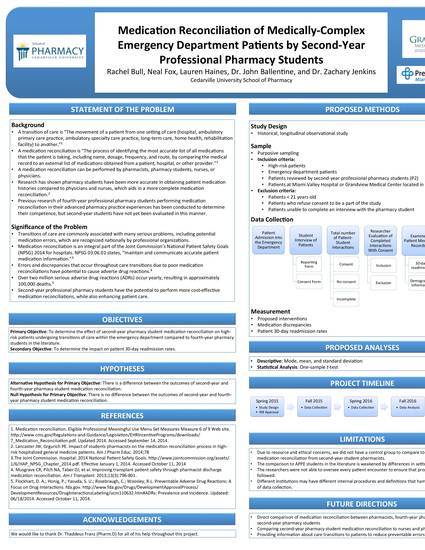
- medication reconciliation,
- pharmacy students,
- emergency department
ABSTRACT:
Background: There is a high potential for medication discrepancies to occur during patient care transitions. However, health professionals must find ways to reduce these and improve patient care, such as with medication reconciliation. This intervention is used to identify a patient’s most accurate medication list by comparing the medical record to another list obtained from the patient, hospital, or other provider. Pharmacists have a major role in this process because of their medicinal expertise, but paying them is expensive, so using students may be more cost-effective. Research has examined fourth-year professional pharmacy students (P4s) performing medication reconciliation during their advanced pharmacy practice experiences; however, no research currently exists that explores the use of P2 students to determine their efficacy.
Objectives: The primary objective of this study is to determine the effect of P2 students on medication reconciliation for high-risk patients undergoing care transitions within the emergency department compared to the efforts of P4s as described in the literature. The secondary objective is to determine the impact on 30-day readmission rates.
Methodology: This is a historical-controlled, prospective, observational study. Data collection will occur August 2015 through April 2016 at Grandview Medical Center and Miami Valley Hospital in Dayton, Ohio. A sample size of at least 34 subjects is required to obtain statistical significance. Subjects will be selected by purposive sampling based on inclusion and exclusion criteria. P2 students will perform medication reconciliation and complete a reporting form providing information on medication discrepancies, interventions, and re-admission dates.
Analysis: Researchers will use descriptive statistics, such as mean, mode, and standard deviation, to report each set of data based on normality. One-sample t-tests will also be used to compare P2 data with pre-existing P4 data found in the literature.
Available at: http://works.bepress.com/zachary_jenkins/21/
